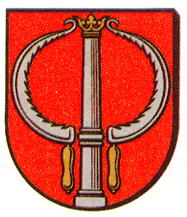Sichelnstein: Difference between revisions
Jump to navigation
Jump to search
Knorrepoes (talk | contribs) m (Text replacement - "|'''German''' | ===Origin/meaning===" to "|'''German''' | |- |'''English''' | {{blazon wanted}} |} ===Origin/meaning=== ") |
Knorrepoes (talk | contribs) m (Text replacement - "===Origin/meaning=== The" to "===Origin/meaning=== The") Tags: Mobile edit Mobile web edit |
||
| Line 20: | Line 20: | ||
===Origin/meaning=== | ===Origin/meaning=== | ||
The arms are canting, showing two sickles (Sicheln) and a pillar ('stein' or stone). The arms were granted by the Dukes of Braunschweig-Lüneburg in the late 18<sup>th</sup> century. The arms were also used by the Amt Münden and later by the Amt Sichelnstein (1830-1973). | The arms are canting, showing two sickles (Sicheln) and a pillar ('stein' or stone). The arms were granted by the Dukes of Braunschweig-Lüneburg in the late 18<sup>th</sup> century. The arms were also used by the Amt Münden and later by the Amt Sichelnstein (1830-1973). | ||
Revision as of 12:59, 18 July 2022
This page is part of the German heraldry portal Deutsche Wappensammlung |
Heraldry of the World |
|
German heraldry:
|
Selected collector's items from Germany:
|
SICHELNSTEIN
State : Niedersachsen
District (Kreis) : Göttingen
Incorporated into : 1973 Staufenberg
| German | |
| English | No blazon/translation known. Please click here to send your (heraldic !) blazon or translation |
Origin/meaning
The arms are canting, showing two sickles (Sicheln) and a pillar ('stein' or stone). The arms were granted by the Dukes of Braunschweig-Lüneburg in the late 18th century. The arms were also used by the Amt Münden and later by the Amt Sichelnstein (1830-1973).
Contact and Support
Partners:
Your logo here ?
Contact us
© since 1995, Heraldry of the World, Ralf Hartemink 
Index of the site
Literature : Information provided by the Staufenberg_council.












